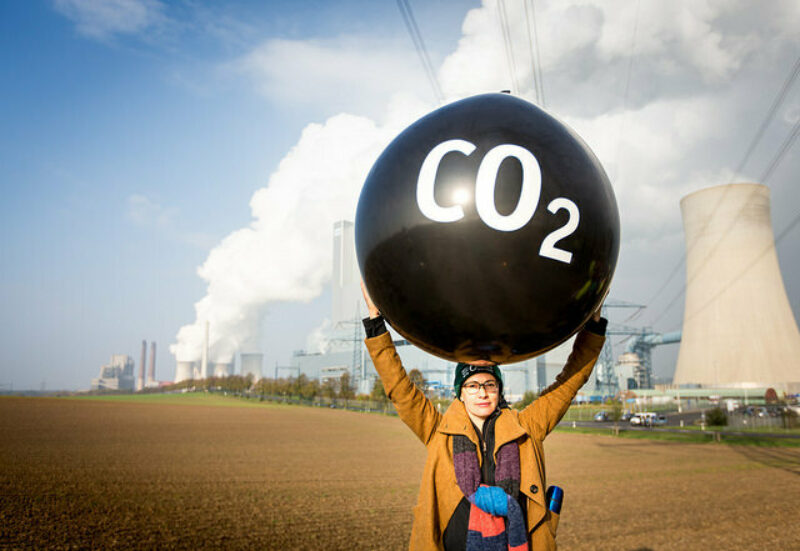Improvement in warming outlook as India and China move ahead, but Paris Agreement gap still looms large
Share

(Full briefing, press conference webcast, and additional resources)
Actions in China and India have made a difference to the CAT’s greenhouse gas (GHG) emissions projections based on government policies currently in place, leading to a 0.2°C decrease in projected warming—to 3.4°C by 2100, compared with 3.6°C in November 2016.
This is the first time since the CAT began tracking action in 2009 that policies at a national level have visibly reduced its end of century temperature estimate and reduced the 2030 emissions gap between policies and what is needed to meet the Paris Agreement 1.5°C temperature limit.
China’s emissions growth has slowed dramatically: in the first decade of this century, its emissions grew by 110%, but between 2010–2015, growth had slowed to only 16%. China is set to far overachieve its climate commitment or Nationally Determined Contribution (NDC). The CAT’s estimate of emissions from China in 2030 is 13 GtCO2e—0.7 GtCO2e lower than its 2016 estimate. If China continues with its coal abatement, this could drop by another 0.7 GtCO2e.
Equally, India has increased its climate action. If India fully implemented its Draft Electricity Plan, its emissions in 2030 would be 4.5 GtCO2e—almost 1 GtCO2e lower than the CAT predicted last year. If it were to strengthen its NDC to match the ambition level of its Draft Electricity Plan, India’s targeted emissions level would be moving much closer to the “1.5°C Paris Agreement compatible” range.
“It is clear who the leaders are here: in the face of US inaction, China and India are stepping up,” said Bill Hare of Climate Analytics. “However, both need to review—and strengthen—their Paris commitments: our projections show they will meet them much earlier than 2030.”
Niklas Höhne of NewClimate Institute added: “Over the last year, governments have made substantial steps in improving climate policies, and this has had a discernible effect on global emissions projections. For example, in the face of increasingly cheaper renewable energy, many are now actively moving away from coal. Electric mobility is also gaining momentum.”
The Climate Action Tracker now projects global emissions under current policies in 2030 to be 1.7 GtCO2e per year lower than last year’s projection. An optimistic case assuming implementation of planned, but not yet implemented, policies is even lower—at 4.1 GtCO2 a year, which would lead to a warming estimate of 3.1°C.<
Due mostly to the USA’s announced withdrawal from the Paris Agreement, there has been a significant deterioration in progress to limit expected warming. If all governments fully implemented their commitments made under the Paris Agreement (NDCs) the projected global temperature increase in 2100 would be 3.2°C above pre-industrial levels, up from last year’s 2.8°C, and largely due to the fact that the US is walking away from its 2025 target and long-term 2050 goal.
Although the 2030 emissions gap between current policies and Paris Agreement compatible emission pathways has narrowed, the NDC commitment gap has widened slightly, as shown in the table above, primarily due to US inaction.
While some of the largest emitters, including China, the EU and India, have either reduced or slowed the growth of their emissions, the CAT warned this does not yet lead to a peaking of global GHG emissions.
![]() <
<
The CAT projects that global emissions are set to rise 9–13% between 2020–2030, due to projected emissions growth in countries such as Turkey, Indonesia and Saudi Arabia. In 17 out of 32 countries analysed by the CAT, emissions will increase by more than 20% during this period.
The CAT assessment covers 32 countries, totalling around 80% of global GHG emissions. The vast majority of NDCs are not in line with a fair contribution to meet the Paris Agreement’s long-term warming goal. Only seven governments have implemented 2°C or 1.5°C compatible targets and of these, four are not backed up by sufficient policy action.
At the same time, in many countries—16 out of 32 assessed by the CAT—emissions are projected to exceed their (already insufficient) NDCs, submitted on ratification of the Paris Agreement. Along with the US, this includes Australia, Brazil, Mexico, and Canada.
“Countries that are clearly on track to overachieve their targets have the opportunity to strengthen them to reflect real emissions development. On the other hand, there are also many governments who have set a low bar for their climate action, but are not even meeting that,” said Yvonne Deng of Ecofys, a Navigant company. “2018 is the right moment for all of these governments to step up climate action.”











